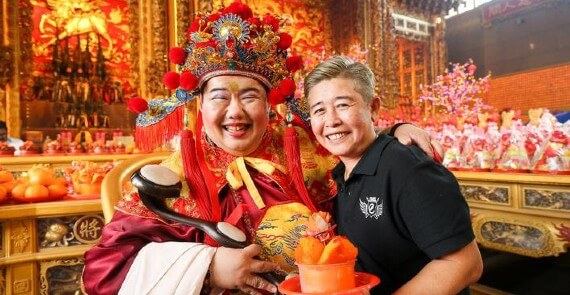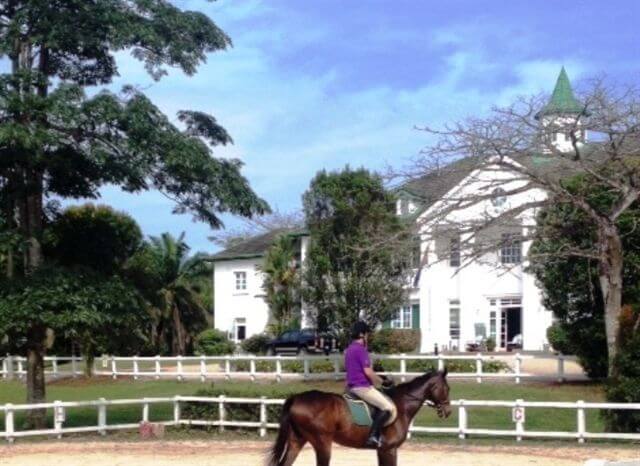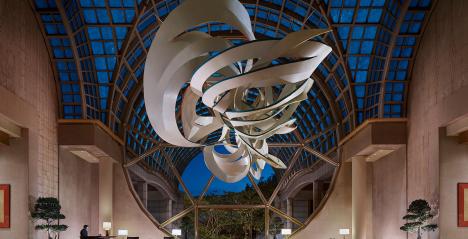Video Credit: CNA Loyang Tua Pek Kong features four multicultural elements in one temple Image Credit: Loyang Tua Pek Kong Temple, Singapore
Wind your clock back to the 1980s. Imagine you and your fishing buddies walking along a deserted beach at the end of the Loyang industrial area, near the eastern edge of Singapore.
Suddenly all of you spotted statues of a Buddhist, Hindu and Taoist deities strewn across the sand. Among your group of fishing buddies is a Mr Paul Tan & Mr Huang Zhong Ting. All of you looked at each other and discussed among yourselves. Finally the group decided to erect a small hut out of bricks and topped it with zinc sheets to house these 3 abandoned statues. If you had been there, you would have just witnessed the birth of the Loyang Tua Pek Kong Temple.
The story continued when one fine day a gentlemen approached the group. He told them that he had received a sign from Allah (Muslim God) who wanted him to build a holy kramat (shrine) to a Holy Muslim man in the same hut. Initially the group didn’t take him seriously. Soon more and more people separately approached them all claiming the same thing – build a shrine to honour the holy Muslim man. Finally the group relented & they set aside a place for the holy kramat to honour the holy Muslim man - Datuk Kong aka Na Tuk Gong.

Image Credit: Loyang Tua Pek Kong Facebook Page
Soon, droves of people, mainly those working in the Loyang industrial area, started visiting this temple by the sea. Miraculous powers were attributed to the temple as devotees claimed that their prayers for prosperity and wealth were always fulfilled. As many as 20,000 devotees of various races can visit the temple every month despite the fact that bus services at that time were limited to week days and the nearest bus stop was half an hour’s walk away.
One of the temple’s claim to fame back then was its 2-metre tall statue of the Hindu god Ganesha, said to be the tallest Ganesha statue in any temple in India or Singapore. Another attraction was the lighting of non-hazardous fire crackers on weekends. The temple was considered unique as it houses Buddhist, Hindu and Taoist deities plus having the Muslim kramat within its premises.
I was fortunate to have seen the temple when it was still located by the sea. Back then, I did not know how interesting the history of the temple was. Unfortunately in 1996, the temple was razed to the ground by a fire. The Taoist statue of Tua Pek Kong, the god of prosperity, was the only one that was miraculously not damaged by the fire, which further enhanced its reputation.
A new premise to house the deities and the kramat had to be built. Public donations poured in and a new temple complex was built on the 1,400 sqm area at 20 Loyang Way to the cost of S$12 million. The new site is about 2 km away from its original site by the seaside. The temple was named after Tua Pek Kong, the god whose statue had survived the fire. In August 2007, the temple re-located to its new premise.
The new temple is divided into sections for Taoism, Buddhism, Hinduism and Datuk Kong. These sections are distinguished by interior architecture styles that reflect their individual religious traditions, including lotus motifs for Buddhism and the yin-yang symbol for Taoism. Stone panels depicting scenes from traditional Chinese culture line the walls of the main hall, and the ceiling features numerous sculpted lanterns and dragons.
The temple’s main prayer hall houses the presiding deity, Tua Pek Kong. This is the statue that survived the fire. It is placed in the centre of the main altar. The hall also include a group of statues representing Tai Sui & other Taoist deities. In the Buddhist section, a Dizang Bodhisattva is enshrined, and an ornately carved abacus with a lotus motif is mounted on the ceiling.
The temple’s other sections contain shrines for Datuk Kong as well as Ganesha and other Hindu deities. Datuk Kong, a Malayan deity inspired by Chinese conceptions of local guardian spirits, is represented by a kramat wrapped with a yellow cloth and housed within an onion dome structure. The 2-metre tall Ganesha, the elephant-headed Hindu deity of wisdom, fortune and the removal of obstacles, is worshipped in the remaining section.
The temple holds yearly celebrations in conjunction with various festivals, such as a celebration to welcome the God of Wealth on the eve of Chinese New Year or celebrate the birth of the Hindu god, Lord Ganesha, on the 5th day of the 8th month of the lunar calendar.
Just a trivia, Tua Pek Kong was actually a man named Zhang Li (张理) from the Hakka clan. His Indonesian Sumatra-bound boat was struck by wind and he accidentally landed on the present Penang island in Malaysia. At that time Penang had only 50 inhabitants. He was believed to have arrived in Penang 40 years earlier than Francis Light in 1746. After his death, the local people began worshipping him and built the Tua Pek Kong Temple there where he was buried behind the Sea Pearl Island Tua Pek Kong Temple in Tanjung Tokong. The story of the first Tua Pek Kong in Penang demonstrates the tradition of sworn brotherhood between the Chinese diaspora.
So the next time you are nearby the Loyang area, drop by the temple and admire how these multi-cultural gods co-exist in harmony.
INFORMATION
a. 20 loyang way Singapore, Singapore 508774
Religious organisation · Religious centre
Loyang Tua Pek Kong Temple is a multi-faith Temple enshrining deity from Taoism, Buddhism and Hinduism. The Temple opens 24hrs daily to service to community. A multi-religious Temple that hosts – Hinduism, Buddhism, Taoism and even a shrine devoted to Datuk Kong all under one vast roof.















